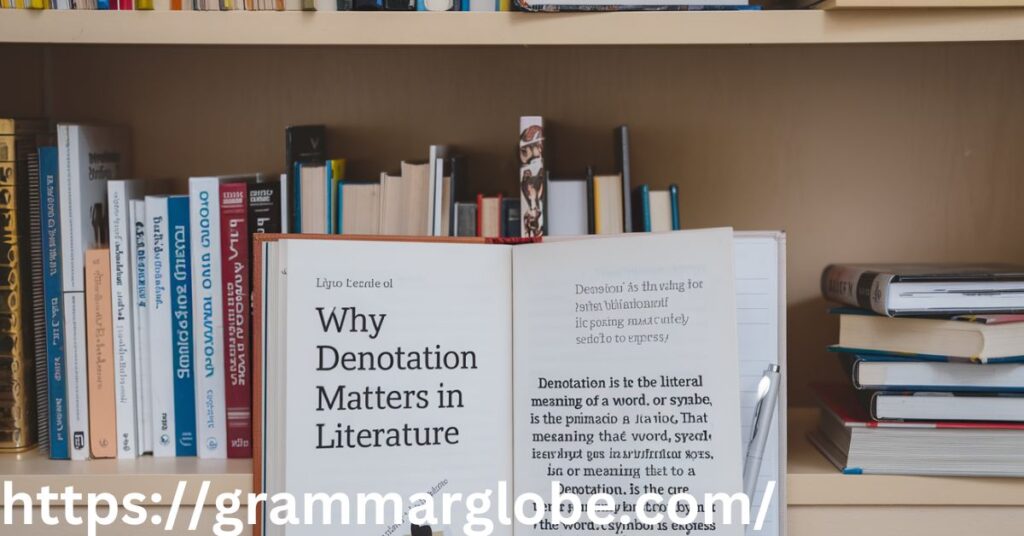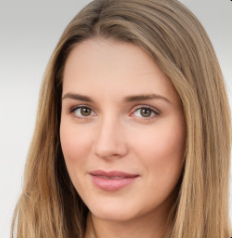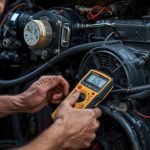In literature, words are more than mere tools; they are vehicles of meaning that shape how stories, poems, and dramas resonate with readers. At the heart of this lies denotation, the literal, dictionary definition of a word. While often overshadowed by the emotional and cultural layers of connotation, denotation serves as the bedrock of communication, denotation examples in literature,providing the clarity needed to anchor deeper interpretations.
For example, when Robert Frost writes about a “road” in The Road Not Taken, its denotative meaning—a physical path—grounds the reader before leading to its symbolic connotations of life choices and decisions. Similarly, Shakespeare’s frequent references to objects like “stars” or “blood” first rely on their literal meanings to establish context before exploring their thematic depth.
Understanding denotation is essential for literary analysis. It helps readers distinguish between what a word directly states and the nuanced emotions or ideas it may evoke. This article explores denotation examples in literature, illustrating its role across genres, from poetry to prose and drama. Whether you’re an avid reader, a student, or a writer, mastering denotation is a critical step toward unlocking the full richness of any text.
What is Denotation?
At its simplest, denotation refers to a word’s explicit, dictionary definition. This contrasts with connotation, which involves the emotional, cultural, or symbolic associations that a word may evoke. By focusing on denotation, writers establish clear communication, grounding their language in objectivity.
For example:
- “Star”: Denotes a luminous celestial body visible at night.
- “Tree”: Denotes a woody plant with branches.
- “Blue”: Denotes the color between green and violet.
While these are straightforward meanings, understanding them is essential when diving into literature where words may carry both denotative and connotative meanings.
Table: Comparing Denotation and Connotation
| Feature | Denotation | Connotation |
|---|---|---|
| Definition | Literal, objective meaning | Emotional, cultural, or symbolic meaning |
| Example: “Rose” | A type of flowering plant | Love, passion, beauty |
| Reliance on Context | Independent of emotional associations | Depends heavily on cultural and situational context |
| Purpose in Literature | Provides clarity and objectivity | Adds depth and emotional resonance |
Why Denotation Matters in Literature

Denotation lays the groundwork for understanding a text. Without recognizing a word’s literal meaning, interpreting its figurative or symbolic implications becomes impossible. Here’s why denotation is so important:
1. Clarity in Communication
Words carry precise meanings that form the backbone of a text. When Shakespeare writes “All the world’s a stage,” we first understand “world” as the literal earth before interpreting its symbolic stage.
2. Enhancing Literary Devices
Metaphors, imagery, and symbolism rely on denotative meanings for structure. Without understanding the denotation of “road” in Frost’s The Road Not Taken, its symbolic resonance as a life choice is lost.
3. Building Vivid Imagery
Literal meanings help readers visualize scenes. In Charlotte Brontë’s Jane Eyre, words like “moor” and “hearth” denote geographical and domestic elements, setting a stark, vivid atmosphere.
Denotation Examples in Literature

In Poetry
Poets use denotation to create clear images while allowing readers to explore deeper connotations.
- William Carlos Williams – “This Is Just to Say”
- The plums in the poem denote literal fruit, placed in an icebox. This denotative clarity allows readers to focus on the poem’s emotional and symbolic elements of temptation and regret.
- Emily Dickinson – “A Bird Came Down the Walk”
- Words like “bird” and “grass” denote their literal meanings, painting a naturalistic scene before leading readers to connotations of freedom and fragility.
In Prose
Authors rely on denotation to anchor their narratives while building symbolic depth.
- George Orwell – 1984
- “Room 101” denotes a physical space, but its connotation as a place of ultimate fear lends a chilling effect.
- F. Scott Fitzgerald – The Great Gatsby
- The “green light” on Daisy’s dock denotes a literal beacon but carries connotations of hope and unattainable dreams.
In Drama
Dramatic texts use denotation to build clear dialogue and actions, often juxtaposed with connotative layers.
- Shakespeare – Macbeth
- The word “blood” denotes a vital fluid, but its connotation shifts throughout the play to symbolize guilt and violence.
Table: Examples of Denotation Across Genres
| Genre | Work | Denotation Example | Connotation |
|---|---|---|---|
| Poetry | Robert Frost – “The Road Not Taken” | Road: A physical path | Life choices, individuality |
| Prose | Harper Lee – To Kill a Mockingbird | Mockingbird: A literal bird | Innocence, vulnerability |
| Drama | Shakespeare – Romeo and Juliet | Star: A celestial object | Fate, destiny |
How Denotation and Connotation Work Together

Denotation and connotation often intertwine to create depth and complexity in literary works. Denotation provides the literal meaning of a word, serving as a foundation for understanding its basic function. Connotation, on the other hand, builds upon this by adding emotional, cultural, or symbolic layers. For instance, the word “home” denotes a physical dwelling, but its connotations can evoke feelings of warmth, safety, or nostalgia.
Authors skillfully use this interplay to craft multilayered meanings. In William Carlos Williams’ This Is Just to Say, “plums” denote fruit, but their connotation suggests temptation and guilt. Similarly, in Shakespeare’s Romeo and Juliet, “stars” denote celestial objects while connoting fate and destiny.
By combining denotation and connotation, writers enhance their storytelling, making language both precise and evocative. This duality allows readers to grasp surface meanings while exploring deeper, subjective interpretations. Understanding how these elements work together enriches literary analysis and deepens one’s appreciation of nuanced writing.
Case Study: Sylvia Plath’s “Mirror”
The poem opens with the line: “I am silver and exact.”
- Denotation: The word “mirror” denotes a reflective surface.
- Connotation: It symbolizes truth, self-perception, and aging.
Plath’s precise language blends denotation and connotation, crafting a multifaceted exploration of identity.
How to Identify Denotation in Literature

Developing the ability to recognize denotative meanings enhances comprehension and analysis. Follow these practical steps:
1. Use Contextual Clues
Words may have multiple meanings depending on their usage. For example:
- In Shakespeare’s Julius Caesar, “snake” denotes a reptile but may also connote treachery.
2. Consult Reliable Sources
Refer to dictionaries for clear, objective definitions before diving into interpretations.
3. Analyze Word Choices
Break down words in a sentence to isolate their literal meanings.
Example Exercise:
Analyze the sentence:
- “The clock struck twelve, and the world changed forever.”
- Clock: Denotes a time-telling device.
- Connotation: May symbolize change or doom, depending on context.
Table: Denotative vs. Connotative Analysis Practice
| Word | Denotation | Connotation | Context in Literature |
|---|---|---|---|
| Light | Illumination | Hope, guidance | “A Light Exists in Spring” by Emily Dickinson |
| Water | A clear liquid | Purity, life, rebirth | “The Waste Land” by T.S. Eliot |
| House | A structure for living | Family, stability, or emptiness | Wuthering Heights by Emily Brontë |
Denotation in Everyday Language vs. Literature

Connotation, on the other hand, builds upon this by adding emotional, cultural, denotation examples in literature,or symbolic layers. For instance, the word “home” denotes a physical dwelling, but its connotations can evoke feelings of warmth, safety, or nostalgia.
Authors skillfully use this interplay to craft multilayered meanings. In William Carlos Williams’ This Is Just to Say, “plums” denote fruit, but their connotation suggests temptation and guilt. Similarly, in Shakespeare’s Romeo and Juliet, “stars” denote celestial objects while connoting fate and destiny.
By combining denotation and connotation, writers enhance their storytelling, making language both precise and evocative. This duality allows readers to grasp surface meanings while exploring deeper, denotation examples in literature,subjective interpretations. Understanding how these elements work together enriches literary analysis and deepens one’s appreciation of nuanced writing.
Common Missteps in Interpreting Denotation
Interpreting literature isn’t always straightforward. Here are common pitfalls to avoid:
1. Overlooking Denotation
Jumping straight to symbolic meanings without acknowledging literal definitions can lead to confusion.
2. Ignoring Context
Words may shift meaning depending on their usage.
3. Confusing Connotation with Denotation
Understanding their differences ensures accurate interpretation.
Fun Activities to Master

Learning denotation can be both educational and engaging. These activities help deepen your understanding of literal meanings while connecting them to broader literary concepts.
1. Word Match Challenge
Create a list of words with their denotative meanings and mix them up. Match the words to their correct dictionary definitions.
| Word | Definition |
|---|---|
| Clock | A device for measuring time |
| Tree | A woody plant with branches |
| Star | A luminous celestial body |
2. Denotation vs. Connotation
Pick a word and explore its literal (denotative) meaning alongside its symbolic (connotative) meaning. For instance:
- Word: “Rose”
- Denotation: A flowering plant.
- Connotation: Love, beauty, passion.
3. Literary Scavenger Hunt
Choose a poem or short story and highlight words with clear denotative meanings. Analyze how these words contribute to the overall imagery or themes.
4. Visual Denotation
Create flashcards with pictures and their corresponding denotative words. For example, a picture of a clock labeled “clock.” This activity is especially great for visual learners.
5. Rewrite with Denotation
Take a sentence heavy with figurative language, like “The stars danced in the sky,” and rewrite it using only denotative words: “The stars appeared in the night sky.” Discuss how the change affects meaning and tone.
By combining creativity with analysis, these activities make mastering denotation an interactive and enjoyable process!
Conclusion:
Denotation, the literal and dictionary definition of words, serves as a foundational element in literature, contrasting with the nuanced layers of connotation. By focusing on a word’s precise meaning, authors craft clarity and immediacy,denotation examples in literature, allowing readers to visualize tangible objects, settings, or ideas without relying on interpretation or symbolism. Denotation provides a neutral framework through which literary works convey straightforward, factual elements, anchoring readers in the reality of the text.
From Sylvia Plath’s coldly precise descriptions in Mirror to Shakespeare’s use of astronomical terms in Romeo and Juliet, denotation enables vivid imagery by using words in their most fundamental sense. Literary examples like William Carlos Williams’ This Is Just To Say and Jane Austen’s Emma demonstrate how relying on denotative meanings enhances straightforward expression, ensuring accessibility and resonance for the audience. Historical and geographical references in Orhan Pamuk’s My Name Is Red highlight the power of denotation in establishing realism and specificity.
While connotation enriches texts with emotional and cultural layers, denotation provides the structure and objectivity necessary for readers to engage with a text’s concrete elements. Together, these linguistic tools create a balance of clarity and depth, making denotation a vital component in literature’s ability to convey both simplicity and sophistication.
FAQs
How does denotation affect readers?
It helps readers visualize and understand the text clearly.
What is denotation in literature?
It’s the literal dictionary meaning of a word, free from emotional or cultural associations.
How is denotation different from connotation?
Denotation is literal meaning, while connotation includes emotional or cultural associations.
Why is denotation important in literature?
It ensures clarity, allowing readers to understand words precisely.
Can you give an example of denotation in a sentence?
In The sky is blue, “blue” denotes a specific color.
What are common examples of denotative words?
Words like “dog” (a mammal) and “tree” (a plant) are examples.
How does Williams use denotation in This Is Just To Say?
He describes “plums” literally as fruit without added meaning.
What is a denotation example in Romeo and Juliet?
Words like “sun” and “moon” are used with their literal meanings.
How does denotation add realism in literature?
Literal meanings make settings and descriptions vivid and factual.
Does denotation limit creativity?
No, it provides clarity while complementing connotation and figurative language.
How is denotation used in Jane Eyre?
Words like “courage” are used in their straightforward, literal sense.
Can denotation and connotation coexist?
Yes, texts often use both for balance and depth.

Irha Queen, a talented writer at grammarglobe.com, specializes in crafting witty puns and exploring the intricacies of English grammar. Her playful yet informative style makes language learning fun, blending humor with clear explanations to engage readers of all levels. Whether she’s spinning clever wordplay or breaking down complex grammar rules, Irha’s content is both entertaining and educational, making her a favorite among language enthusiasts.






